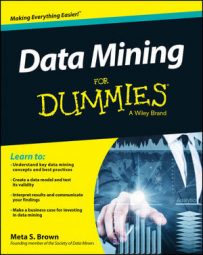Rushing your choice of data-mining software comes with risks. Your data-mining projects begin with plans. Until you have defined what you intend to accomplish and your own working requirements, don’t focus on software. Good preparation protects you from these common risks:
Inadequate software capabilities: New data miners often find that the software they’ve selected doesn’t have the full set of capabilities they require. Although it’s tempting to blame the problem on the software provider, that excuse probably won’t satisfy your boss or client.
The first and most important way to avoid selecting products that don’t meet your requirements is to delay the selection of software until you have completed a thorough assessment to determine what those requirements will be. After you have a good understanding of what you need, it makes sense to plan appropriate tests before committing to a purchase. Always test software before settling on a product.
Evaluate a variety of products. Free products are, of course, easily accessible, and most commercial software vendors will let you test their products for a short time at no charge. Make the most of these trials by preparing a test plan and defining success criteria before you begin.
If your software test demands a significant amount of technical assistance from a vendor, such as bringing a support person to your site for several days, you will likely be asked to pay a fee for that service. (Keep this in mind when considering free software. Companies that distribute their software free often make money selling services.) Vendors will sometimes apply those fees toward your software purchase. If that isn’t offered, ask.
Sometimes, the problem isn’t really that the software lacks a necessary capability, but that the data miner hasn’t learned enough about how to use it. Plan on training for any product you acquire, and start training as soon as you bring a tool in-house.
Overpaying: People often do not even realize that they have bought a more expensive product than they needed. While the most cost-effective choice for you is not necessarily the one with the lowest price tag, there is no point in paying for product features that you will not use.
Your best defense against paying too much is to do some comparison shopping — with your list of requirements in hand. If a sales representative encourages you to select a more expensive product than you think you need, ask questions.
Ask what additional capabilities are provided in the pricier product, and how they are relevant to you. Get enough information to let you determine whether the upgrade would actually be more valuable to your organization, or just increase the sales representative’s commission.
Unnecessary complexity: When data miners sit down to carry out a project with a new tool, they sometimes find it harder to use than they expected. Sometimes, it’s clear that the tool can do what’s needed, but not easily. In other cases, it may appear that the product simply can’t meet a requirement.
One way to avoid unnecessary complexity is to try products before making a selection. Always give software a through trial before committing to use it in a real application.
Good data-mining tools are designed to help business users discover useful patterns in data quickly. At least, that’s the goal. The real-life truth, though, is that it still takes effort to understand new tools and complete projects.

